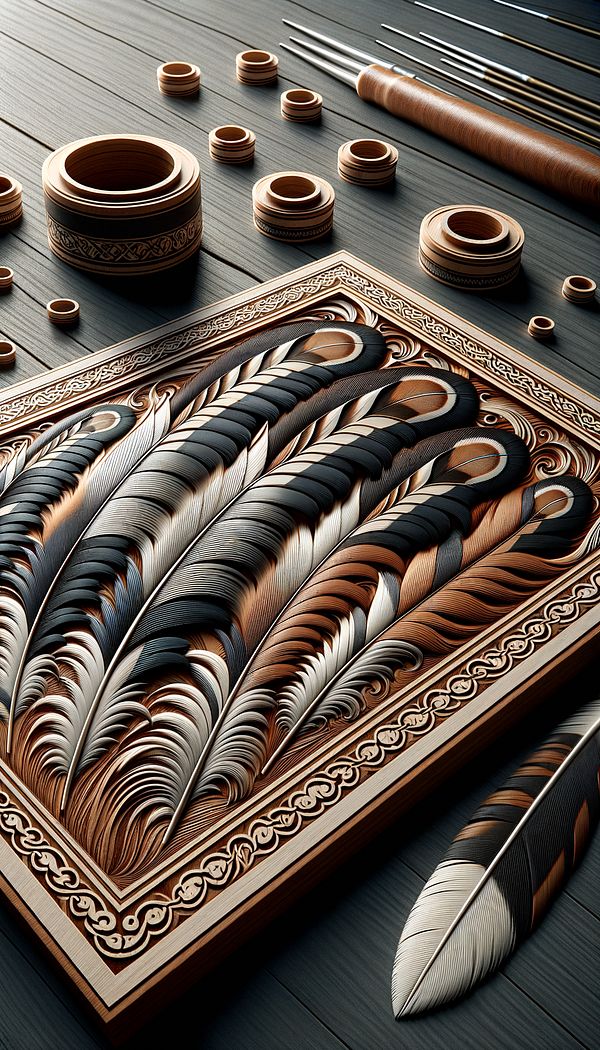What is Feather Banding?
Feather banding is a decorative technique used in woodworking.
Description
Feather banding is an intricate decorative technique found in the world of furniture types|furniture and textiles and [[upholstery|woodworking]], noted for its distinctive pattern resembling the end of a feather or series of feathers. This technique involves inlaying thin pieces of contrasting wood, veneer, or other materials into the surface of a piece of furniture or wooden object in a way that mimics the layered pattern of a feather's edge. The end result is a finely detailed, visually appealing decoration that adds depth, texture, and sophistication to furniture pieces.
Originally popular during the 17th and 18th centuries in European furniture making, particularly in Britain, feather banding was a hallmark of high-quality cabinetmaking and craftsmanship. It was often used on the edges of table tops, cabinet fronts, and drawers, contributing an air of elegance and exclusivity to the pieces. The choice of materials for the inlays, such as different woods or metals, along with the precision of the craftsmanship, played a crucial role in the overall aesthetics of the technique.
In contemporary interior design, feather banding can be seen in both traditional and modern furniture pieces, bridging the gap between historical craftsmanship and modern aesthetics. It's a testament to the enduring appeal and versatility of detailed woodworking techniques.
Usage
In modern interior spaces, feather banding is often utilized in the design of statement furniture pieces such as dining tables, cabinets, and writing desks. Designers may choose this technique to add a sense of luxury and intricacy to a room, effectively blending historical charm with contemporary design elements. Due to its detailed nature, feather banding is particularly well-suited for pieces that serve as focal points in a room, offering both visual interest and a nod to craftsmanship traditions.
FAQs
-
Is feather banding exclusive to antique furniture?
No, while feather banding has its roots in antique furniture design, it is also used in contemporary furniture to add elegance and detail.
-
Can feather banding be used on all types of wood?
Feather banding can be applied to various types of wood, but the contrast between the inlay and the base wood is key to achieving the desired visual effect.
-
How is feather banding created?
Feather banding is created by carefully inlaying thin pieces of contrasting material into the surface of the wood in a pattern that resembles the edge of a feather.
Practical Application
When considering incorporating feather banding into your design project, focus on choosing the right piece of furniture to adorn with this technique. Consider the overall style of the room and how a piece with feather banding can complement or enhance the space. The materials and colors of the inlays should be thoughtfully selected to ensure they stand out against the base wood, creating a striking contrast. Due to the detailed and intricate nature of feather banding, it's often best reserved for high-quality pieces where craftsmanship can truly shine.
-
Furniture Types599 articles
-
Decorative Techniques322 articles
-
Fabrication & Craftsmanship133 articles
-
Materials & Textiles360 articles
-
Pull-Up LeatherPull-up leather is a type of leather known for its color-changing quality when stretched or pulled.
-
MinimalistA design style characterized by simplicity, clean lines, and a monochromatic palette with color used as an accent.
-
BoucléBouclé is a textured fabric known for its looped or curled ply yarns creating a unique and tactile experience.
-
Full Grain LeatherFull grain leather is the highest quality of leather available.
-
UnityUnity in interior design refers to the harmonious arrangement of elements within a space that creates a cohesive and coherent look.
